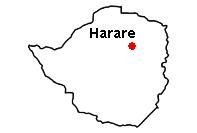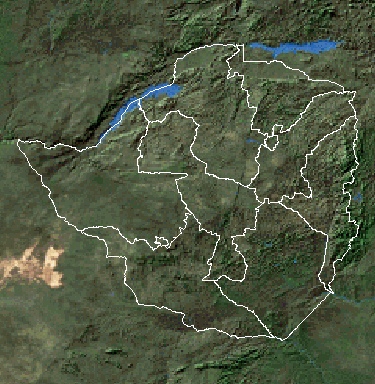|
|  |
| back to top | |
|
Population. The cheetah once occurred throughout Zimbabwe, but is now largely absent from the north and east of the country. Estimates of the cheetah population over the last 30 years range from 400 to 1,500, but many of these figures are not based on reliable data, and no current estimates are available. The cheetah population is thought to have been stable or decreasing in protected areas, and increasing on private land. The fast track land resettlement programme (FTLRP) initiated in 2000 may have affected the present status and distribution of the cheetah, but this has not yet been investigated. Cheetahs are legally hunted as problem animals and as trophies, but insufficient data are available to assess the impact of hunting on the population. Illegal removals may also have an important impact on the population. It is suggested that research is conducted to determine the current status and distribution of the cheetah population, and how this may have been affected by recent land use changes. In addition, it is recommended that trophy quality should be monitored, and information on non-lethal predator management techniques should be provided to farmers (Williams 2007). |
|
| back to top | |
|
The UK annexed Southern Rhodesia from the [British] South Africa Company in 1923. A 1961 constitution was formulated that favored whites in power. In 1965 the government unilaterally declared its independence, but the UK did not recognize the act and demanded more complete voting rights for the black African majority in the country (then called Rhodesia). UN sanctions and a guerrilla uprising finally led to free elections in 1979 and independence (as Zimbabwe) in 1980. Robert MUGABE, the nation's first prime minister, has been the country's only ruler (as president since 1987) and has dominated the country's political system since independence. His chaotic land redistribution campaign, which began in 2000, caused an exodus of white farmers, crippled the economy, and ushered in widespread shortages of basic commodities. Ignoring international condemnation, MUGABE rigged the 2002 presidential election to ensure his reelection. Opposition and labor strikes in 2003 were unsuccessful in pressuring MUGABE to retire early; security forces continued their brutal repression of regime opponents. The ruling ZANU-PF party used fraud and intimidation to win a two-thirds majority in the March 2005 parliamentary election, allowing it to amend the constitution at will and recreate the Senate, which had been abolished in the late 1980s. In April 2005, Harare embarked on Operation Restore Order, ostensibly an urban rationalization program, which resulted in the destruction of the homes or businesses of 700,000 mostly poor supporters of the opposition, according to UN estimates. ZANU-PF announced in December 2006 that they would seek to extend MUGABE's term in office until 2010 when presidential and parliamentary elections would be "harmonized." | |
| back to top | |
|
Area: total: 390,580 sq km; land: 386,670 sq km; water: 3,910 sq km Climate: tropical; moderated by altitude; rainy season (November to March) Terrain: mostly high plateau with higher central plateau (high veld); mountains in east Land use: arable land: 8.24%; permanent crops: 0.33%; other: 91.43% (2005) Natural resources: coal, chromium ore, asbestos, gold, nickel, copper, iron ore, vanadium, lithium, tin, platinum Natural hazards: recurring droughts; floods and severe storms are rare Environment-current issues: deforestation; soil erosion; land degradation; air and water pollution; the black rhinoceros herd-once the largest concentration of the species in the world-has been significantly reduced by poaching Environment-international agreements: party to: Biodiversity, Climate Change, Desertification, Endangered Species, Law of the Sea, Ozone Layer Protection |
|
|
|
|
| back to top | |
|
Population: 12,236,805 (July 2006 est.) Age structure: 0-14 years: 37.4% (male 2,307,170/female 2,265,298); 15-64 years: 59.1% (male 3,616,528/female 3,621,190); 65 years and over: 3.5% (male 199,468/female 227,151) (2006 est.) | |
|
Median age: total: 19.9 years; male: 19.7 years; female: 20 years (2006 est.) Population growth rate: 0.62% (2006 est.) Infant mortality rate: total: 51.71 deaths/1,000 live births; male: 54.5 deaths/1,000 live births; female: 48.83 deaths/1,000 live births (2006 est.) Life expectancy at birth: total population: 39.29 years; male: 40.39 years; female: 38.16 years (2006 est.) Total fertility rate: 3.13 children born/woman (2006 est.) HIV/AIDS - adult prevalence rate: 24.6% (2003 est.) HIV/AIDS - people living with HIV/AIDS: 1.8 million (2003 est.) HIV/AIDS - deaths: 170,000 (2003 est.) Major infectious diseases: food or waterborne diseases: bacterial diarrhea, hepatitis A, and typhoid; vectorborne disease: malaria; water contact disease: schistosomiasis (2007) |
|
|
Ethnic groups: African 98% (Shona 82%, Ndebele 14%, other 2%), mixed and Asian 1%, white less than 1% Religions: syncretic (part Christian, part indigenous beliefs) 50%, Christian 25%, indigenous beliefs 24%, Muslim and other 1% Languages: English (official), Shona, Sindebele (the language of the Ndebele, sometimes called Ndebele), numerous but minor tribal dialects Literacy: definition: age 15 and over can read and write English; total population: 90.7%; male: 94.2%; female: 87.2% (2003 est.) |
|
| back to top | |
|
Data code: ZI Government type: parliamentary democracy Independence: 18 April 1980 (from UK) Legal system: mixture of Roman-Dutch and English common law | |
| back to top | |
|
Economy-overview: The government of Zimbabwe faces a wide variety of difficult economic problems as it struggles with an unsustainable fiscal deficit, an overvalued exchange rate, soaring inflation, and bare shelves. Its 1998-2002 involvement in the war in the Democratic Republic of the Congo drained hundreds of millions of dollars from the economy. The government's land reform program, characterized by chaos and violence, has badly damaged the commercial farming sector, the traditional source of exports and foreign exchange and the provider of 400,000 jobs, turning Zimbabwe into a net importer of food products. Badly needed support from the IMF has been suspended because of the government's arrears on past loans, which it began repaying in 2005. The official annual inflation rate rose from 32% in 1998, to 133% in 2004, 585% in 2005, and approached 1000% in 2006, although private sector estimates put the figure much higher. Meanwhile, the official exchange rate fell from approximately 1 (revalued) Zimbabwean dollar per US dollar in 2003 to 250 per US dollar in August 2006. Labor force: 3.958 million (2006 est.) Labor force-by occupation: agriculture: 66%; industry: 10%; services: 24% (1996) Unemployment: 80% (2005 est.) Population below poverty: 80% (2004 est.) Industries: mining (coal, gold, platinum, copper, nickel, tin, clay, numerous metallic and nonmetallic ores), steel; wood products, cement, chemicals, fertilizer, clothing and footwear, foodstuffs, beverages | |
|
Agriculture-products: corn, cotton, tobacco, wheat, coffee, sugarcane, peanuts; sheep, goats, pigs Exports: $1.766 billion f.o.b. (2006 est.) Exports-commodities: cotton, tobacco, gold, ferroalloys, textiles/clothing Exports-partners: South Africa 26.9%, China 7.9%, Japan 6.7%, Zambia 5.5%, Netherlands 5.4%, US 4.9%, Italy 4.5%, Germany 4.4% (2005) Imports: $2.055 billion f.o.b. (2006 est.) Imports-commodities: machinery and transport equipment, other manufactures, chemicals, fuels Imports-partners: South Africa 52.5%, China 5.7%, Botswana 4.1% (2005) Currency: 1 Zimbabwean dollar (Z$) = 100 cents |
|
|
Exchange rates: Zimbabwean dollars per US dollar - 162.07 (2006), 77.965 (2005), 5.729 (2004), 0.824 (2003), 0.055 (2002); note: these are official exchange rates; non-official rates vary significantly |
|
| back to top | |
|
Telephone system: general assessment: system was once one of the best in Africa, but now suffers from poor maintenance; more than 100,000 outstanding requests for connection despite an equally large number of installed but unused main lines; domestic: consists of microwave radio relay links, open-wire lines, radiotelephone communication stations, fixed wireless local loop installations, and a substantial mobile cellular network; Internet connection is available in Harare and planned for all major towns and for some of the smaller ones; international: country code - 263; satellite earth stations - 2 Intelsat; two international digital gateway exchanges (in Harare and Gweru) Radio broadcast stations: AM 7, FM 20 (plus 17 repeater stations), shortwave 1 (1998) Television broadcast stations: 16 (1997) Internet country code: .zw Internet hosts: 7,954 (2006) Internet users: 1 million (2005) | |
| back to top | |
|
Williams S. 2007. Status of the Cheetah in Zimbabwe. Cat News Special Issue 3, 31-35. http://www.cia.gov/cia/publications/factbook/geos/zi.html (last update on 10 January, 2006) http://en.wikipedia.org/wiki/Zimbabwe http://www.lib.utexas.edu/maps/map_sites/country_sites.html#zimbabwe | |





